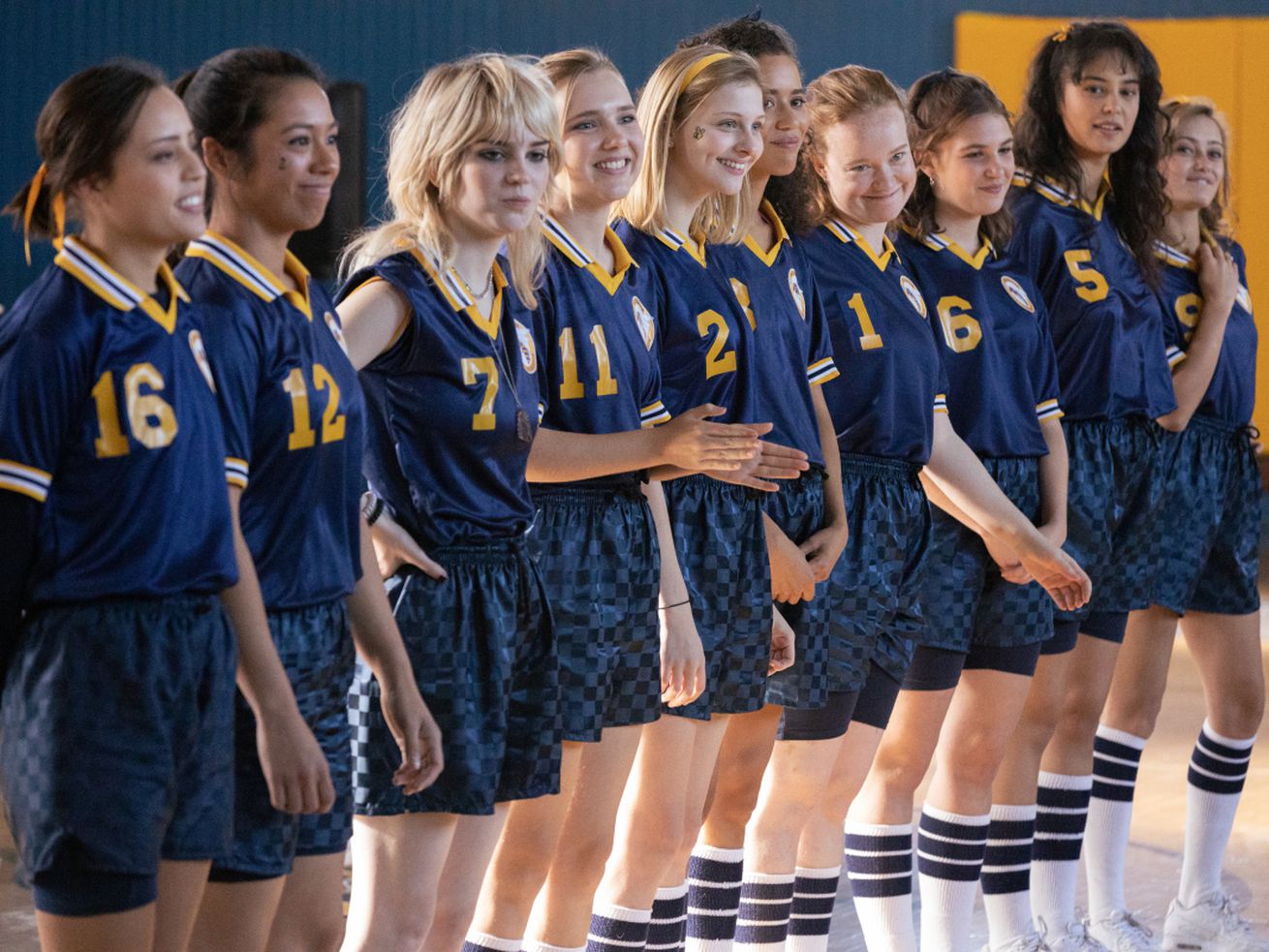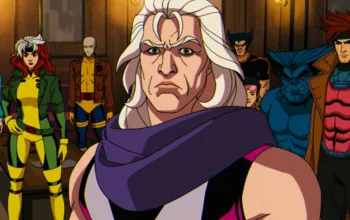Showtime’s new drama vivisects teen girl friendships. It got its toolkit from teen soap operas.
Showtime’s new horror show Yellowjackets is one of the buzziest hits of the season. Boasting a murderer’s row of ’90s teen stars, frankly appalling gore, and a pet bird named Caligula, Yellowjackets is a vicious, bloody examination of the all-consuming force of teen girl friendships and how they can devour you whole. Sometimes, the show makes clear, quite literally.
Moving along two timelines, Yellowjackets follows members of a high school girls’ soccer team in 1996, as well as select survivors of the team in the present. In 1996, the team is stranded by a plane crash in the remote Canadian wilderness for 19 months. In the present, the survivors are riddled with PTSD and struggling to keep the secret of what they really did out there in the wilderness 25 years ago. Whatever it was, it seems to have involved some ritual cannibalism.
As Yellowjackets opens, we see a young girl with long dark hair running through the woods, face hidden. Robed and hooded figures are hunting her, driving her with eerie animal noises into a covered pit full of spikes. Once they catch her, they bleed her dry, cook her over a fire, and eat her. A figure crowned with antlers and veils watches over the whole thing. We know they’re all our girls, but we don’t know who is who.
As Vox critic-at-large Emily VanDerWerff has already argued, part of the alchemy of Yellowjackets is the way it slams the conventions of different TV genres up against one another. The show combines the sort of puzzle-box mystery show plotting popularized by Lost with astute psychological excavations of trauma along the lines of a show like Succession, plus a healthy amount of good old-fashioned horror stemming from its Lord of the Flies-style premise. It seems built to inspire equal amounts of fan theorizing about its mysteries, analytical essays about how trauma shapes character, and shared notes on how many nightmares it has inspired among its fans.
But I’d like to argue that in addition to its pedigreed antecedents, Yellowjackets is also pulling some tropes from a rather less-respected genre. A surprising amount of Yellowjackets’s structure seems to be borrowed from the microgenre of teen soap operas about sexy teens being blackmailed over their sexy secrets; teen shows about surveillance; teen shows that treat secrets as weapons and social capital as the stuff of life-and-death stakes.
Specifically, Yellowjackets is pulling an awful lot from Pretty Little Liars, the campy Freeform drama that ran from 2010 to 2017. Pretty Little Liars gives Yellowjackets two of its central mysteries: the question of what happened to the alpha girl at the top of a friend group, and the identity of a mysterious and apparently all-knowing blackmailer. Looking into what the two shows have in common reveals a lot about the emotional ambivalence at the heart of a friendship that gives teen girl horror its teeth — and about how Yellowjackets is thinking about its core emotional dynamic.
Yellowjackets and Pretty Little Liars share a dual structure
Pretty Little Liars was one of the sudsiest and silliest teen soap operas of the 2010s. It had no aspirations toward prestige, but it gloried in its own ridiculousness.
The show concerned a group of five high school girl friends, all with various intimate and humiliating secrets. (One was covering up her dad’s affair, another was hiding her eating disorder, a third was in the closet.) Only the alpha girl of the group, Alison (Sasha Pieterse), successfully kept her secrets to herself. All of her friends surrendered their confidences to her, and Alison used those admissions to manipulate in ways large and small.
A year before the show begins, Alison goes missing and is presumed dead. As the show kicks off, each of the remaining four friends begins to receive menacing texts from someone who seems to know all their secrets and is threatening to spill. The texts are signed, ominously, “A”.
Over the course of seven seasons, A leads the protagonists of Pretty Little Liars through a series of terrifying and degrading stunts. Periodically, the Liars unmask A, but another A always emerges to take on the role, and the Liars always have new secrets for each new A to exploit. It was the sort of show in which, on multiple occasions, characters hid their identities by wearing lifelike rubber masks.
Fundamentally, Pretty Little Liars and Yellowjackets are doing different kinds of horror. Pretty Little Liars was campy, over-the-top absurd. Yellowjackets is full of unabashed gore, genuinely nightmarish, and willing to indulge in camp only when the delightful Christina Ricci is onscreen. But the two shows use a similar horror vocabulary — menacing parrots, haunted-looking dolls — and a flashback structure built around the mysterious disappearance of the alpha girl leader of the central friend group in the past, and an omniscient blackmailer in the present.
There’s a reason both shows use this dual structure. It’s perfect for teasing out the dark secrets that come with adolescent girlhood.
When the alpha friend goes missing, you have the space to admit that maybe you love her and maybe you hate her
Let’s start with the flashbacks. For Pretty Little Liars, the missing alpha girl is Alison, and a central question of the first few seasons is whether Alison is secretly A. For Yellowjackets, the missing alpha girl is Jackie (Ella Purnell), one of the few central figures we’ve met so far solely in the 1996 flashbacks.
In 1996, Jackie is the captain of the Yellowjackets team, pretty and popular and just lightly bitchy. Her best friend is Shauna (Sophie Nélisse), a studious, quiet type who is apparently happy to follow in Jackie’s wake, showing only the slightest, heavily smothered resentment at Jackie’s tendency to treat her as a sidekick.
After the plane crash, however, Jackie’s control over the Yellowjackets falters, and her friendship with Shauna begins to splinter. Jackie has no outdoorsy skills and no desires to develop any, which means she has little to offer the starving team. She listens to music on a Walkman while the rest of the group builds fires and hunts deer and scrubs laundry. Every time she offers up an idea for the group, like staying at the plane crash site instead of looking for water, someone more practical shoots it down.
Shauna maintains that she and Jackie are still friends, but she sides against Jackie on group votes, and one night she moves her sleeping bag away from Jackie’s. It also becomes clear she’s keeping secrets. She’s pregnant, and Jackie’s boyfriend Jeff is the father.
In the present-day timeline, Jackie remains unaccounted for. She’s discussed only in the past tense. While we don’t know exactly what happened to her, it seems very plausible that she was involved in the cannibalistic ceremony that opened the show. What remains to be seen is whether she was the victim — or whether she was the figure in veils and antlers, known to the audience only as the Antler Queen, who led the ceremony.
The missing alpha friend structure is key to what both Yellowjackets and Pretty Little Liars are doing. It creates a space for both shows to play with the ambivalence of a certain kind of teen girl friendship, the way love and admiration and desire and fear can all mingle in the same place.
The Liars love Alison. They buy her intimacy by giving her their secrets, and then they resent her for using those secrets against them. They aspire to be her, to be as pretty and glamorous and confident as she is, and they hate her for being prettier and more glamorous and confident than they are. They miss her, but they’re also sort of glad she’s gone. And it seems fully within the realm of possibility to them that she might be their blackmailer.
Shauna, meanwhile, loves Jackie. She loves her so much she sleeps with Jackie’s boyfriend, in an act of both self-sabotage and a kind of sympathetic magic, as though by sharing Jeff with Jackie she’s bringing them closer together. She also hates Jackie so much that she sleeps with Jackie’s boyfriend. As an adult, she viscerally and vocally despises her daughter, who is clearly like Jackie in personality, and who Shauna once briefly mistakes for Jackie.
Shauna seems to miss Jackie, but maybe she’s also sort of glad she’s gone.
That present-day plotline also leads us to the other big Pretty Little Liars-Yellowjackets parallel: blackmail.
Teen shows are obsessed with surveillance and blackmail. Yellowjackets takes the trope a step further.
In the 2021 timeline, all the adult Yellowjackets we meet, save Shauna, are being blackmailed by someone who knows what they did out there in the wilderness. The blackmailer sends them taunting messages, A-style, about how they know the Yellowjackets’ secrets. And each message is signed with the same symbol: a collection of circles and lines that the Yellowjackets found engraved everywhere in the wilderness, which from a certain angle looks like a stick figure representation of a girl impaled on spikes.
Like A, the Yellowjackets’ blackmailer repeats that signature symbol so often that it veers back and forth from threatening to comic. A arranged for the Liars to open a container of alphabet cereal and find that every single letter was A; the Yellowjackets’ blackmailer painstakingly recreates the symbol in emoticon form to use as the signoff to a text, where it takes on a certain jauntiness.
Both blackmailers seem to know everything about their victims. They must be someone the victims know and trust, but who?
The trope of an all-seeing and all-knowing blackmailer is a durable one within teen soaps. Pretty Little Liars was itself heavily influenced in this regard by Gossip Girl before it. The blackmail trope nearly always seems to land, because it picks up one of the overwhelming horrors of teen girlhood: those are the years when you first become aware of yourself as the object of the male gaze. They are the years when you realize that you are being watched, that you always will be, and that you will always be found wanting. The idea of making the watcher into a murky all-knowing villain, one who can eventually be unmasked and defeated, is deeply appealing.
Yellowjackets marries that familiar horror to a deeper, more primordial fear: You are being watched and you are being found wanting, not just because of the patriarchy, but because there is something monstrous deep within you that deserves to be judged. The secrets the Yellowjackets are hiding aren’t innocent secrets like those of the Liars. They aren’t covering up their parents’ mistakes or their private self-harm or their unexplored sexuality. They’re covering up actual cannibalism.
So in the Yellowjackets universe, you aren’t only A’s victim. You’re A.
One of the most unsettling things about Yellowjackets is that as of now, we have no way of knowing for sure who the leader of the cannibals is, who her victims are, or where our present-day main characters threw their loyalties when they were in the wilderness. We’ve only seen the face of one of the robed figures in that opening sequence, the character of Misty. Knowing that Misty was a chief lackey for the Antler Queen frees us up to treat her as an entertaining villain, but our other characters inhabit a more ambiguous space, at once potential killers and potential victims.
That ambiguity makes us queasily aware of one of the most uncomfortable truths of teen girl friendship: The one with the upper hand isn’t always the one who hurts most ruthlessly. The figures at the core of the group aren’t rejects but aren’t queen bees like Jackie, either, and it’s easy to like them. But that doesn’t mean we’re not always aware they could well have done terrible things, or that they could well do terrible things in the future.
It all comes back to that central friendship again, that vicious teen girl space where love and resentment and desire mingle. On Yellowjackets, Jackie holds more social capital than Shauna. Jackie also loves Shauna. She wants to possess or control Shauna: tell her how to dress, who to date, what she deserves in life, and how to get it. Jackie hurts Shauna, casually and unthinkingly, with offhanded putdowns and small pieces of cruelty.
And in return, Shauna loves Jackie. Shauna wants to be, or possess, Jackie. Shauna hurts Jackie, knowingly and deliberately, by sleeping with her boyfriend.
Which one is the cannibal? Well, they both are. We all could be. That’s Yellowjackets.
Author: Constance Grady
Read More



